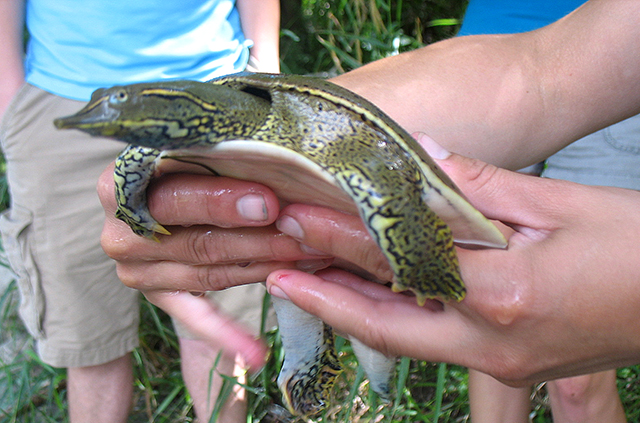
Partnering Organizations and Resources
Turtle Research
The Milwaukee and Menomonee Rivers and the Washington Park lagoon are host to several species of turtles including snapping turtles, soft-shelled turtles and painted turtles. We know this because of the work community scientists have contributed to the project since 2008.
Turtle surveys are conducted by canoe using baited hoop traps. Turtles are marked and released to help us determine population dynamics. If getting in hip waders and canoeing to traps is not your style, we also conduct leisurely walking surveys, looking for turtles basking in the morning sun.

Smooth softshell turtle

Hoop traps
The Center’s turtle research has received valuable funding from:
- The Milwaukee County Zoological Society
- The Citizen-based Monitoring Network of Wisconsin’s Partnership Program.
- The Environmental Protection Agency’s Great Lakes Research Initiative
Show you value turtles in our urban ecosystem with a gift!
Mammal Research
The Center’s mammal monitoring program was piloted in 2005 and uses visual surveys, live trapping and camera surveillance to monitor presence/absence and population trends. Large diurnal mammals are identified through visual surveys, while field cameras are employed to document similar-sized nocturnal mammals. Sherman folding traps and pitfall traps are used to identify small nocturnal mammals.
We study the population trends and presence of small mammal species in our parks using live trapping and mark-recapture methods over the course of two or three consecutive mornings, multiple times throughout the summer field season. Filmed here is our Menomonee Valley branch in 2019.
Show you value mammals in our urban ecosystem with a gift!
Current and past research studies borne from this project include a nest box study, a scent comparison study and a predatory exclosure study. Mammal monitoring runs from June – August and welcomes curious community members to the project.

Walk through Riverside Park with Wisconsin DNR biologist Dianne Robinson to assess beaver activity. Photo: Jessica Orlando

The beaver (Castor canadensisis) has made a return to Riverside Park in the last few years. Photo: Bruce Halmo
Besides beavers, there have been river otter sightings downtown along the Milwaukee River, beginning winter 2019. We also had a sighting on the west bank of the river right across from the UEC. It will be interesting to see if otter sightings become more frequent as water quality and quality of habitat improves along the Milwaukee River.
The Urban Ecology Center’s mammal research has received valuable funding from:
- The Citizen-based Monitoring Network of Wisconsin’s Partnership Program
- The Environmental Protection Agency’s Great Lake’s Restoration Initiative
Invertebrate Research
Invertebrates (animals without backbones) are often good indicators of environmental health, which is especially important as the Center makes large-scale changes to the native plant communities at its branches. Community efforts are crucial in monitoring the effects of recently-created green spaces such as the Milwaukee Rotary Centennial Arboretum and Three Bridges Park on invertebrate communities. The Urban Ecology Center also participates in national projects, such as the Monarch Larvae Monitoring Project, Monarch Watch, and the 4th of July Butterfly Count.
If you are interested in helping the Urban Ecology Center with invertebrate research, please contact Maggie Steinhauer at This email address is being protected from spambots. You need JavaScript enabled to view it..
Show you value insects in our urban ecosystem with a gift!
For more information on the Monarch Larva Monitoring Project, please visit: www.mlmp.org
For more information on Monarchwatch, please visit: www.monarchwatch.org
For more information on the 4th of July Butterfly count please visit: http://www.naba.org/counts.html


The Urban Ecology Center’s invertebrate research has received valuable funding from:
- The Environmental Protection Agency’s Great Lakes Research Initiative
Bat Research
Bats are the second most diverse group of mammals in the world. There are over 900 known species, eight of which are found in Wisconsin. Bats provide important ecosystem services like insect control and pollination. Unfortunately, White-nose Syndrome (WNS), a deadly fungal infection, is spreading through North America at an alarming rate killing hundreds of thousands of bats.
 Big brown bats (Eptesicus fuscus), with a wingspan of 12-16 inches and an average weight of about an ounce, aren't actually all that big! Photo: Joe Meyer
Big brown bats (Eptesicus fuscus), with a wingspan of 12-16 inches and an average weight of about an ounce, aren't actually all that big! Photo: Joe Meyer
In collaboration with the Wisconsin DNR, the Urban Ecology Center is helping researchers determine baseline bat population dynamics using high-tech Anabat detectors that identify bats by recording their ultrasonic calls. A stationary detector records year-round from Riverside and mobile detectors help community researchers monitor bats on properties throughout Southeast Wisconsin. A GPS unit allows us to plot survey locations, as well as the time, location and often species identification of the bats we encounter.
If you are interested in helping the Urban Ecology Center research and monitor bats, please contact Maggie Steinhauer at This email address is being protected from spambots. You need JavaScript enabled to view it..
For more information on Wisconsin’s bats and WNS, please visit: http://wiatri.net/inventory/bats/

Teaching budding community scientists about the Anabat acoustic bat detector.
The Urban Ecology Center’s bat research has received valuable funding from:
- The Citizen-based Monitoring Network of the Wisconsin DNR’s Partnership Program.
- The Environmental Protection Agency’s Great Lakes Research Initiative
- And by a generous donation from Verne and Marion Read
The Center has also received collaborative support from the Wisconsin DNR, Escuela Verde, Mequon Nature Preserve and the University of Wisconsin Stevens Point.
Show you value bats in our urban ecosystem with a gift!
Copyright © 2023 The Urban Ecology Center


